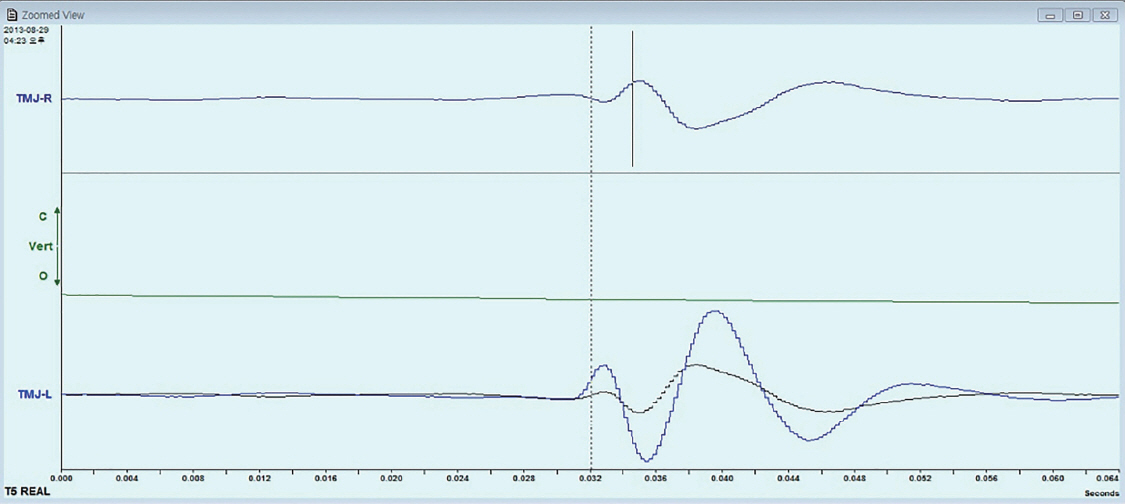J Dent Rehabil Appl Sci.
2016 Mar;32(1):38-46. 10.14368/jdras.2016.32.1.38.
Study for discriminating method of origin side vibration from non-symptomatic clicking group
- Affiliations
-
- 1Department of Prosthodontics, School of Dentistry, Chosun University, Gwangju, Republic of Korea. dwkang@chosun.ac.kr
- KMID: 2162378
- DOI: http://doi.org/10.14368/jdras.2016.32.1.38
Abstract
- PURPOSE
study for discriminating method of origin side vibration from non-symptomatic clicking group.
MATERIALS AND METHODS
60 joints vibrations of 30 subjects in non-symptomatic clicking group was recorded via subject's awareness, examiner's palpation and JVA analysis. Origin side vibration was discriminated with consideration for frequency spectrum, time delay and phase shift of waveforms, analysis of numeric values.
RESULTS
There were all unilateral vibrations with JVA analysis and number of origin vibrations were 42. 11 pairs of vibrations showed time delay and phase shift and transferred side vibrations showed smaller values of total integral and bigger values of > 300 / < 300 ratio than origin side vibrations except one pair of vibrations. Also as the ipsi-lateral joint vibrations with smaller values of total integral showed bigger values of > 300 / < 300 ratio than the contra-lateral joint vibrations and there all ipsi-lateral vibrations were showed small values of total integral below 10 and hard to detect time delay and phase shift. So the features were used in discrimination of origin side vibrations.
CONCLUSION
There should be all-around considerations for discrimination of origin side vibrations that is frequency spectrum, phase shift and time delay and analysis of numeric values.
MeSH Terms
Figure
Reference
-
References
1. Eriksson L, Westesson PL, Rohlin M. Temporomandibular joint sounds in patients with disc displacement. Int J Oral Surg. 1985; 14:428–36. DOI: 10.1016/S0300-9785(85)80075-2.2. Okeson JP. Management of temporomandibular disorders and occlusion. 2004. 5th ed. Seoul: Mosby a division of Elsevier;p. 201.3. Wabeke KB, Spruijt RJ, van der Zaag J. The reliability of clinical methods for recording temporomandibular joint sounds. J Dent Res. 1994; 73:1157–62. PMID: 8046104.4. Christensen LV. Physics and the sounds produced by the temporomandibular joints. Part I. J Oral Rehabil. 1992; 19:471–83. DOI: 10.1111/j.1365-2842.1992.tb01111.x. PMID: 1453259.5. Christensen LV. Physics and the sounds produced by the temporomandibular joints. Part II. J Oral Rehabil. 1992; 19:615–27. DOI: 10.1111/j.1365-2842.1992.tb01111.x. PMID: 1469497.6. Gay T, Bertolami CN. The spectral properties of temporomandibular joint sounds. J Dent Res. 1987; 66:1189–94. DOI: 10.1177/00220345870660061901. PMID: 3476592.7. Gallo LM, Airoldi R, Ernst B, Palla S. Power spectral analysis of temporomandibular joint sounds in asymptomatic subjects. J Dent Res. 1993; 72:871–5. DOI: 10.1177/00220345930720050701. PMID: 8501284.8. Widmalm SE, Williams WJ, Djurdjanovic D, Mckay DC. The frequency range of TMJ sounds. J Oral Rehabil. 2003; 30:335–46. DOI: 10.1046/j.1365-2842.2003.01099.x. PMID: 12631156.9. Sano T, Widmalm SE, Westesson PL, Takahashi K, Yoshida H, Michi K, Okano T. Amplitude and frequency spectrum of temporomandibular joint sounds from subjects with and without other signs/ symptoms of temporomandibular disorders. J Oral Rehabil. 1999; 26:145–50. DOI: 10.1046/j.1365-2842.1999.00348.x. PMID: 10080312.10. Ishigaki S, Bessette RW, Maruyama T. Diagnosis accuracy of TMJ vibration analysis for internal derangement and/or degenerative joint disease. Cranio. 1994; 12:241–5. DOI: 10.1080/08869634.1994.11678028. PMID: 7828206.11. Li X, Lin X, Wang Y. Temporomandibular joint vibration in bruxers. Cranio. 2009; 27:167–73. DOI: 10.1179/crn.2009.025. PMID: 19697644.12. Kernohan WG, Beverland DE, McCoy GF, Shaw SN, Wallace RG, McCullagh GC, Mollan RA. The diagnostic potential of vibration arthrography. Clin Orthop Relat Res. 1986; 210:106–12. DOI: 10.1097/00003086-198609000-00014.13. Sharma S, Crow HC, McCall WD Jr, Gonzalez YM. Systematic review of reliability and diagnostic validity of joint vibration analysis for diagnosis of temporomandibular disorders. J Orofac Pain. 2013; 27:51–60. DOI: 10.11607/jop.972. PMID: 23424720.14. Radke JC, Kull RS. Comparison of TMJ vibration frequencies under different joint conditions. Cranio. 2015; 33:174–82. DOI: 10.1179/2151090314Y.0000000019. PMID: 25079855.15. Zhang J, Whittle T, Wang L, Murray GM. The reproducibility of temporomandibular joint vibrations over time in the human. J Oral Rehabil. 2014; 41:206–17. DOI: 10.1111/joor.12141. PMID: 24527845.16. Widmalm SE, Williams WJ, Ang BK, McKay DC. Localization of TMJ sounds to side. J Oral Rehabil. 2002; 29:911–7. DOI: 10.1046/j.1365-2842.2002.00928.x. PMID: 12421322.17. Radke JC, Kull RS. Distribution of temporomandibular joint vibration transfer to the opposite side. Cranio. 2012; 30:194–200. DOI: 10.1179/crn.2012.030. PMID: 22916672.18. Widmalm SE, Williams WJ, Yang KP. False localization of TMJ sounds to side is an important source of error in TMD diagnosis. J Oral Rehabil. 1999; 26:213–4. DOI: 10.1046/j.1365-2842.1999.00372.x. PMID: 10194729.19. Eriksson L, Westesson PL, Sjoberg H. Observer performance in describing temporomandibular joint sounds. Cranio. 1987; 5:32–5. DOI: 10.1080/08869634.1987.11678171. PMID: 3467864.20. Ishigaki S, Bessette RW, Maruyama T. Vibration analysis of the temporomandibular joints with degenerative joint disease. Cranio. 1993; 11:276–83. DOI: 10.1080/08869634.1993.11677979. PMID: 8118898.21. Huang ZS, Lin XF, Li XL. Characteristics of temporomandibular joint vibrations in anterior disk displacement with reduction in adults. Cranio. 2011; 29:276–83. DOI: 10.1179/crn.2011.041. PMID: 22128667.22. Ishigaki S, Bessette RW, Maruyama T. Vibration of the temporomandibular joints with normal radiographic imagings: comparison between asymptomatic volunteers and symptomatic patients. Cranio. 1993; 11:88–94. DOI: 10.1080/08869634.1993.11677948. PMID: 8495512.23. Widmalm SE, Westesson PL, Brooks SL, Hatala MP, Paesani D. Temporomandibular joint sounds: correlation to joint structure in fresh autopsy specimens. Am J Orthod Dentofacial Orthop. 1992; 101:60–9. DOI: 10.1016/0889-5406(92)70083-M.24. Tse KM, Tan LB, Lim SP, Lee HP. Conventional and complex modal analyses of a finite element model of human head and neck. Comput Methods Biomech Biomed Engin. 2015; 18:961–73. DOI: 10.1080/10255842.2013.864641. PMID: 24328395.
- Full Text Links
- Actions
-
Cited
- CITED
-
- Close
- Share
- Similar articles
-
- Changes of Vibration-Induced Nystagmus by Age in Normal Subjects
- Usefulness of vibration perception time in assessment of vibration sensory impairment
- Effects of Applying a Vibration Stimulation to Paretic Side and Non-Paretic Side on Balance and Gait in Stroke Patients: a Pilot Study
- Dizziness Control in Virtual Reality by Vibration Stimulation in Mastoid
- Quantitative Sensory Test for the Detection of Diabetic Peripheral Neuropathy





